Files in this item
The effects of invasive pests and pathogens on strategies for forest diversification
Item metadata
| dc.contributor.author | Macpherson, Morag F. | |
| dc.contributor.author | Kleczkowski, Adam | |
| dc.contributor.author | Healey, John R. | |
| dc.contributor.author | Quine, Christopher P. | |
| dc.contributor.author | Hanley, Nick | |
| dc.date.accessioned | 2017-02-27T10:30:15Z | |
| dc.date.available | 2017-02-27T10:30:15Z | |
| dc.date.issued | 2017-04-24 | |
| dc.identifier | 249242285 | |
| dc.identifier | cbb2471b-2a3a-4584-8302-fdc54e37fa84 | |
| dc.identifier | 85013805247 | |
| dc.identifier | 000398876800008 | |
| dc.identifier.citation | Macpherson , M F , Kleczkowski , A , Healey , J R , Quine , C P & Hanley , N 2017 , ' The effects of invasive pests and pathogens on strategies for forest diversification ' , Ecological Modelling , vol. 350 , pp. 87-99 . https://doi.org/10.1016/j.ecolmodel.2017.02.003 | en |
| dc.identifier.issn | 0304-3800 | |
| dc.identifier.other | RIS: urn:4C477FA4CF1EBF1A8D018329FA5A2104 | |
| dc.identifier.uri | https://hdl.handle.net/10023/10373 | |
| dc.description | This is one of seven projects in the Tree Health and Plant Biosecurity Initiative (phase 2) funded by BBSRC, Defra, ESRC, Forestry Commission, NERC and Scottish Government. | en |
| dc.description.abstract | Diversification of the tree species composition of production forests is a frequently advocated strategy to increase resilience to pests and pathogens; however, there is a lack of a general framework to analyse the impact of economic and biological conditions on the optimal planting strategy in the presence of tree disease. To meet this need we use a novel bioeconomic model to quantitatively assess the effect of tree disease on the optimal planting proportion of two tree species. We find that diversifying the species composition can reduce the economic loss from disease even when the benefit from the resistant species is small. However, this key result is sensitive to a pathogen's characteristics (probability of arrival, time of arrival, rate of spread of infection) and the losses (damage of the disease to the susceptible species and reduced benefit of planting the resistant species). This study provides an exemplar framework which can be used to help understand the effect of a pathogen on forest management strategies. | |
| dc.format.extent | 13 | |
| dc.format.extent | 1053086 | |
| dc.language.iso | eng | |
| dc.relation.ispartof | Ecological Modelling | en |
| dc.subject | Bioeconomic modelling | en |
| dc.subject | Forest management | en |
| dc.subject | Natural resource management | en |
| dc.subject | Tree pests and pathogens | en |
| dc.subject | Tree species diversification | en |
| dc.subject | GE Environmental Sciences | en |
| dc.subject | SD Forestry | en |
| dc.subject | QH301 Biology | en |
| dc.subject | NDAS | en |
| dc.subject.lcc | GE | en |
| dc.subject.lcc | SD | en |
| dc.subject.lcc | QH301 | en |
| dc.title | The effects of invasive pests and pathogens on strategies for forest diversification | en |
| dc.type | Journal article | en |
| dc.contributor.sponsor | BBSRC | en |
| dc.contributor.institution | University of St Andrews. Geography & Sustainable Development | en |
| dc.identifier.doi | https://doi.org/10.1016/j.ecolmodel.2017.02.003 | |
| dc.description.status | Peer reviewed | en |
| dc.identifier.grantnumber | BB/L012561/1 | en |
This item appears in the following Collection(s)
Items in the St Andrews Research Repository are protected by copyright, with all rights reserved, unless otherwise indicated.

